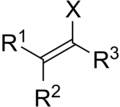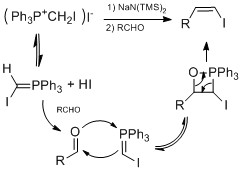
In organic chemistry, a vinyl halide is a compound with the formula CH2=CHX (X = halide). The term vinyl is often used to describe any alkenyl group. For this reason, alkenyl halides with the formula RCH=CHX are sometimes called vinyl halides. From the perspective of applications, the dominant member of this class of compounds is vinyl chloride, which is produced on the scale of millions of tons per year as a precursor to polyvinyl chloride. [1] Polyvinyl fluoride is another commercial product. Related compounds include vinylidene chloride and vinylidene fluoride.


